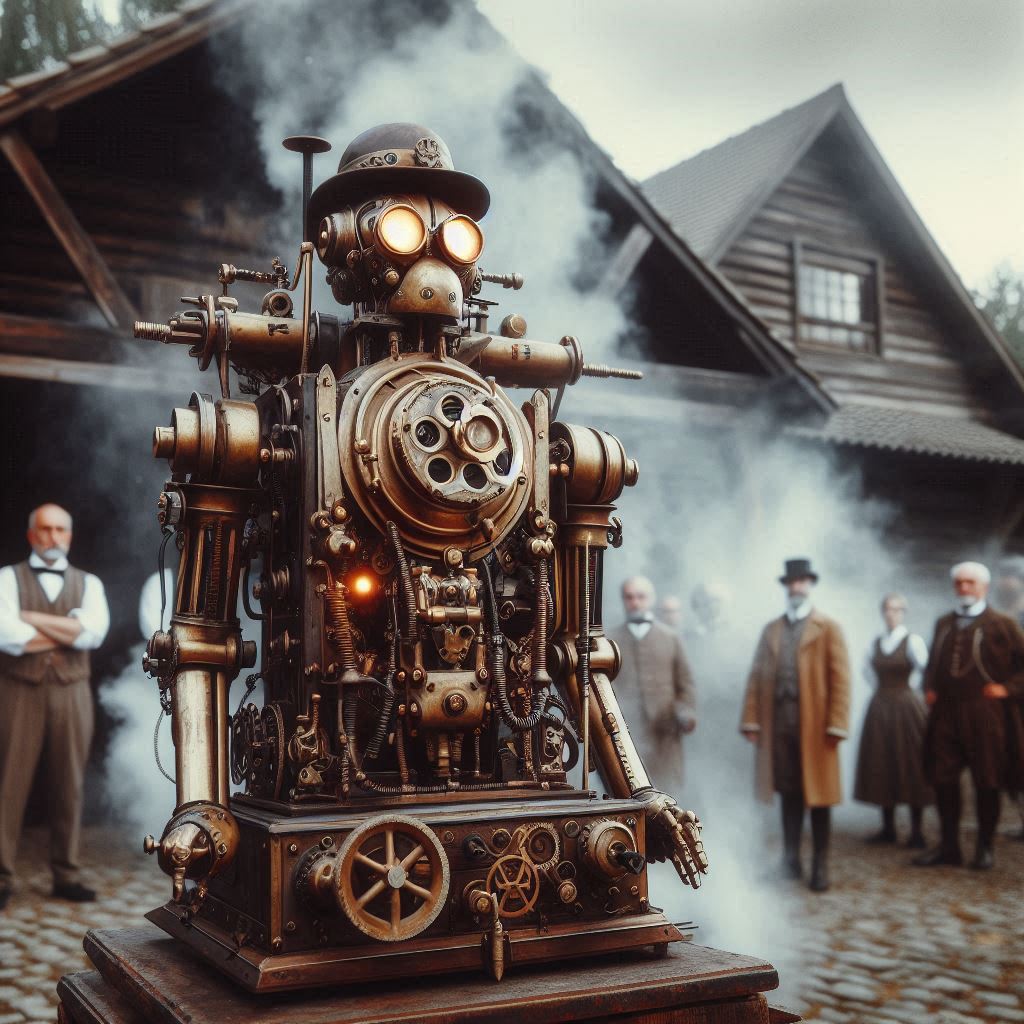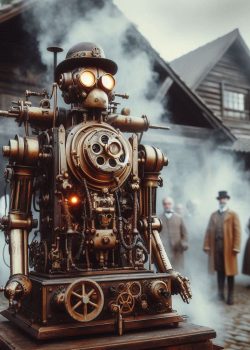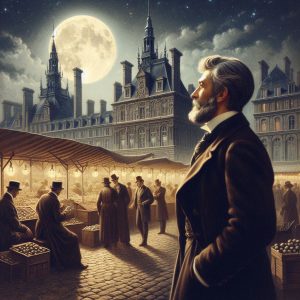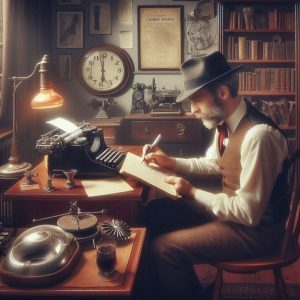
(Previous)…..(Content)…..(Next)
The decisive infiltration of the “Science” genre into “Fantasy”
The period 1900-1939: The true “beginning”
(Romanian)
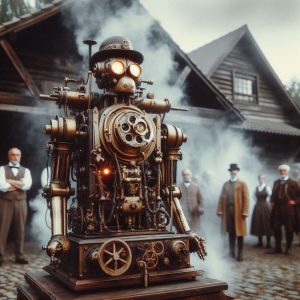
From the point of view of the realities of humanity, concerning fiction, in the early 1900s, it produced a transition from “fantasy” to “science fiction”…
A natural evolution, a continuation of the works of authors such as Jules Verne or H.G. Wells, given the great scientific discoveries that occurred during this period, decisively influencing the following generations of writers who developed and refined the basic elements of “science fiction”, creating subgenres and exploring more complex themes.
Yes, without a doubt, we are approaching a period in which we are dealing with the transition from the “fantasy” genre to “science fiction” as we perceive it today, which was facilitated by the great scientific discoveries and technological progress of the 20th century.
During this period (this episode refers to the period up to World War II), there was, first of all, the rapid development of industry and the massive migration of the population to cities, which led to the manifestation of a feeling of alienation and detachment from nature.
Additionally, the “background” of the rapid pace of scientific discoveries also contributes, not to mention the anxieties developed by the carnage of the “Great War”, which stimulated people to look to the future with a combination of optimism and anxiety, which fueled the imagination of writers, the traumatic experiences of the “Great War” generating a need for escape and exploration of alternative worlds, be they utopian or dystopian.
I think no one can dispute the fact that the “great slaughter” of World War I (The Great War) accelerated the pace of technological progress (technological development), in a “vicious circle” that stimulated the imagination of writers, who explored the possibilities offered by new inventions.
Then, the “Great War” also attracted the political revolutions that followed (the fracture of the homogeneity of imperialism under the blow of communism), with a profound impact on science fiction literature, leaving deep traces in the collective psyche, generating anxiety about the future and a desire to explore alternative scenarios (a desire that is also manifested in these times).
A fracture that the masses also felt from the point of view of propaganda, which almost became generalized, facilitating the explosion of “print” among the general public…
“Access” attracted an amplification of the popularization of science (books, press releases, exhibitions, and other scientific popularization efforts) and determined that scientific ideas and discoveries were accessible to a wide audience and, in particular, to fiction literature.
This is why, in terms of scientific discoveries, certainly revolutionary, we can recall discoveries such as the theory of relativity, quantum mechanics, “mass” automation, the first “certain atomic elements”, even the first “mass” airplane flights, which opened up new perspectives on the world and stimulated the imagination of writers with an optimistic, post-war flow.
Thus, the development of science fiction literature offered an escape, but also a space to reflect on the consequences of technology and conflict, also based on ideological polarizations, initiated by the confrontation between capitalism and communism (which generated a multitude of utopian and dystopian visions), not to mention fascist ideologies and the “reawakening” of imperialism.

Themes such as time travel, encounters with aliens or descriptions of “alien” worlds, contact with extraterrestrial beings, and the transformation of life under the imperative of technology impacting society, have forced the “modernization” of fantasy.
Thus, many of the traditional fantasy elements were reinterpreted and adapted to the new realities. For example, mythical creatures were replaced with aliens, and magic was explained through science.
Drawing on a “science fiction” transformation of “fantasy” elements, many works of science fiction retain fantastical elements, such as mythical creatures or magical worlds, but “explain” them through science.
A transformation that was “felt” through the birth of subgenres, such as cyberpunk, steampunk, and space opera, which combine elements of science fiction with other literary genres.
To cut a long story short, the transition from fantasy to science fiction was a gradual and complex process, influenced by a multitude of social, cultural, and scientific factors.
And, instead of seeing these two genres (“science fiction” and “fantasy”) as opposites, it is more accurate to consider them as two sides of the same coin, both exploring fundamental questions about human nature and our place in the universe, described more or less scientifically, but, necessarily, fictionally, narratively.
But, let’s move on to some examples and “final descriptions”!
The early 1900s period continued a kind of transition for the fantasy genre, given the fact that there was not yet a clear demarcation between fantasy and science fiction, with many of the works written during that period laying the foundations for what would become a literary genre in its own right.
There were times when the “written book” had fairly limited accessibility to the mass of readers, the propagation of “valuable” work being quite “heavy”, “fashionable” or scientific works (effectively) being “preferred”…
Perhaps that is why, regarding the future “science fiction” genre, we are witnessing a kind of development of the folklore heritage, scientific “insertions” often being “rejected” for fear of an “unproductive” investment…
So, we are dealing with a kind of “genre” continuity, with many authors drawing inspiration from European and world folklore, creating stories with fairies, wizards, mythical creatures, and fantasy worlds, with the idea of a kind of escape into an idealized world, out of the desire to discover the magical side of reality and the interest in the past…
Choices by writers “became” central themes in fantasy novels of this period, with many of the tropes and conventions of the modern fantasy genre being established during this period.

So, although there was no distinct demarcation for fantasy at the time (the lack of a precise definition of the genre being clear, many of the authors did not consider themselves fantasy writers, and many of the novels were classified as both fantasy and children’s stories or gothic novels), many novels can be considered precursors of the genre, such as:
- „The Wind in the Willows” by Kenneth Grahame (1908): A timeless story about talking animals having adventures in an idealized world, it has influenced generations of readers and become a classic of children’s literature.
- „Peter Pan” by J.M. Barrie (1911): A story about a boy who refuses to grow up and has adventures in Neverland, alongside fairies and pirates.
- The works of Lord Dunsany: Irish writer Lord Dunsany created dark and atmospheric fantasy worlds, with gods, monsters, and heroic adventures.
- William Morris: The author wrote historical and utopian novels, such as „News from Nowhere”, which explore themes related to socialism and nature (being one of the precursors of the Arts and Crafts movement, Morris wrote utopian novels and fantasy stories, exploring themes related to nature and society).
- George MacDonald: A Scottish writer who created fantasy stories for children, inspiring generations of authors, including C.S. Lewis (known for „The Chronicles of Narnia”).
- culminating in „The Hobbit” de J.R.R. Tolkien (1937): Although published at the end of the period, this novel laid the foundations of a complex and rich fantasy world, which influenced entire generations of writers, the fantasy world created by J.R.R. Tolkien becoming a landmark for the fantasy genre.
But, let’s not forget, Tolkien was not alone!
First, we can remember the 1920s, when the Science Fiction period of Pulp Magazines “started” (which would develop significantly until around the 1950s), initially in the possible mix of those “transitional” times (F-SF), playing an essential role in the formation and popularization of the science fiction genre, providing a platform for the writers who laid the foundations of modern SF.
These magazines, printed on low-quality paper (hence the name “pulp”), dominated the popular literature market for several decades.
But, “accessing” the chronological thread, before the appearance of magazines dedicated exclusively to science fiction, speculative stories were published in general fiction magazines, such as The Argosy or The All-Story, the first exclusively science fiction magazine being “Amazing Stories“, founded in 1926 by Hugo Gernsback, considered the “father of modern science fiction”.
This was followed by magazines such as “Astounding Science Fiction” (1930, edited by John W. Campbell) and Weird Tales (devoted more to horror and fantasy).
Most pulp stories were dominated by adventurous heroes, space explorers, brilliant scientists, and epic conflicts between galactic civilizations. Some of these stories had a solid scientific basis, but many used science only as a pretext for adventure, preferring sensational images of giant robots, evil aliens, and dangerous inventions. The narrative style was simplistic but captivating, with many stories being written in a fast-paced, action-packed style to captivate young readers.
However, it is certainly credited that this period was a launching pad for some of the greatest writers of “Fantasy” and “Science Fiction” (possibly SF-F), such as:
- Edgar Rice Burroughs (A Princess of Mars) – planetary adventures with heroic heroes and alien civilizations.
- E.E. “Doc” Smith (Lensman, Skylark of Space) – a precursor to space opera.
- H.P. Lovecraft (The Call of Cthulhu, At the Mountains of Madness) – cosmic horror with sci-fi influences.
- Jack Williamson (The Legion of Space, Darker Than You Think) – space opera and science fantasy.
- Robert E. Howard (Conan the Barbarian, Almuric) – fantasy with sci-fi influences.
- L. Ron Hubbard (Final Blackout, Typewriter in the Sky) – typical pulp sci-fi adventures.
The “pulp” effect will continue for many years, until the public (reader) will be mostly attracted only to true works of the “Science Fiction” genre, possibly to its subgenres, depending on the tastes that have been clarified/delimited…
Returning to the novels of the “times” (mostly F-SF), before Tolkien, many other authors explored fantastic themes, creating worlds and characters that inspired entire generations of readers.
But the publication of “The Hobbit” coincided with a period of great social and cultural transformations, and the novel offered readers an escape into a magical and adventurous world (the entire series and the continuation via “Lord of the Rings” following the realities of the evolution of humanity in the times contemporary to those publications, in a “fantasy” type “presence”).

And this definite evolution can be seen both in the novels written over the years, and, for example, in the novels of the end of this period:
- „The Sword in the Stone”, by T. H. White (1938, the first part of the tetralogy „The Once and Future King”), is a classic novel that presents us with a unique interpretation of the legend of King Arthur, which “invites” us, instead of focusing on Arthur’s adventures as a king, to participate in a journey through Arthur’s childhood and adolescence, before he assumes the role of leader. Thus, instead of focusing on the famous battles and tournaments, White presents us with a story about the formation of a future king, where the magician Merlin is presented as a funny and intelligent mentor, who teaches young Arthur important lessons about life and the world around him. One of the most memorable features of the novel is the way Merlin transforms Arthur into different animals, to teach him about the natural world and the different aspects of life. Being the first part of a tetralogy, the other parts will explore in detail Arthur’s reign, his fall, and the legend of the Holy Grail.
- „Out of the Silent Planet”, by C. S. Lewis (1938), is the first volume of the “Space Trilogy”, standing out as a Christian approach to science fiction, bringing to this trilogy a Christian vision of space exploration. He creates a universe in which the planets are populated by intelligent and moral beings, and space travel becomes an allegory for spiritual travel; for example, we are dealing with a planet Mars very different from H.G. Wells’ dark visions of Mars, Lewis presenting us with a beautiful planet populated by gentle and wise beings. Elwin Ransom, the protagonist of the novel, is a philologist who is kidnapped and taken to Mars, initially being considered to be cargo, to be sacrificed, becoming a kind of messiah for the Martians, helping them understand the nature of evil and sin (criticizing materialism and scientism, claiming that there is a spiritual reality that exceeds our scientific understanding).
- „Galactic Patrol”, by E. E. Smith (1938), is a kind of first classic space epic (space opera in the superlative), a seminal work of science fiction, originally published in 1937, and is often considered one of the first examples of “space opera”, a subgenre of science fiction that focuses on large-scale space adventures, galactic exploration, and epic confrontations between civilizations. This novel, the first in an epic series, introduces us to a vast and complex universe dominated by a galactic-scale struggle between good and evil. The novel features extremely advanced technology, including spacecraft capable of super-light speeds, energy weapons, and interstellar communication devices. Like many works of science fiction, “Galactic Patrol” presents an epic battle between the forces of good, represented by the Galactic Patrol, and the forces of evil, led by the space pirates Boskone, with the protagonist, Kimball Kinnison, standing out, is a charismatic and powerful hero, endowed with exceptional psychic abilities thanks to the “Lens”, a device that amplifies his mental powers. Smith creates a vast and complex universe, with numerous alien races, civilizations, and advanced technologies, the novel promotes ideas such as justice, order,r and progress, inspiring generations of readers.
- „The Legion of Time”, by Jack Williamson (1938), is another emblematic work of science fiction, a novel that takes us on an epic journey through time and space, exploring themes such as time travel, the evolution of humanity, and the fight for survival. The novel explores the concept of time travel in an innovative way, presenting a secret organization that controls the flow of time and is involved in a cosmic conflict, the time legion being involved in a continuous fight to protect the timeline and prevent changes that could have catastrophic consequences, the protagonist being sent to different historical periods to carry out important missions. Thus, the novel presents different stages of human evolution, from primitive people to advanced alien civilizations, Williamson describes futuristic technologies such as time machines, spaceships, and energy weapons, standing out as a captivating story, full of action, intrigu,e and complex characters.
- „Carson of Venus”, by Edgar Rice Burroughs (1938), is a hidden gem in the work of Edgar Rice Burroughs, best known for his Tarzan series. Published in 1938, this novel takes us on a thrilling space adventure on the planet Venus, while Tarzan has accustomed us to the African jungle, Carson Napier, the protagonist of this series (an adventurer who ends up on Venus through a miscalculation), “lives” his adventures on a planet with a dense atmosphere, lush jungle and a variety of extraterrestrial creatures (different alien races, each with their own cultures and technologies). As in all of Burroughs’ novels, the action is fast-paced and suspenseful, with Carson Napier facing warring tribes, dangerous creatures, and the political intrigues of a complex Venusian society. Like Tarzan, Carson is a romantic and courageous hero who falls in love with a Venusian princess and fights to defend the people he loves, “transforming” the novel into an important work in the history of science fiction, which has influenced generations of writers.

Novels that describe this transitional period, but certainly the true “beginning” of “science fiction”…
Merticaru Dorin Nicolae
